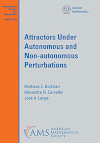- About MAA
- Membership
- MAA Publications
- Periodicals
- Blogs
- MAA Book Series
- MAA Press (an imprint of the AMS)
- MAA Notes
- MAA Reviews
- Mathematical Communication
- Information for Libraries
- Author Resources
- Advertise with MAA
- Meetings
- Competitions
- Programs
- Communities
- MAA Sections
- SIGMAA
- MAA Connect
- Students
- MAA Awards
- Awards Booklets
- Writing Awards
- Teaching Awards
- Service Awards
- Research Awards
- Lecture Awards
- Putnam Competition Individual and Team Winners
- D. E. Shaw Group AMC 8 Awards & Certificates
- Maryam Mirzakhani AMC 10 A Awards & Certificates
- Two Sigma AMC 10 B Awards & Certificates
- Jane Street AMC 12 A Awards & Certificates
- Akamai AMC 12 B Awards & Certificates
- High School Teachers
- News
You are here
Attractors Under Autonomous and Non-autonomous Perturbations

Buy Now:
Publisher:
AMS
Publication Date:
2020
Number of Pages:
246
Format:
Hardcover
Series:
Mathematical Surveys and Monographs
Price:
140.00
ISBN:
978-1-4704-5308-4
Category:
Monograph
[Reviewed by , on ]
Bill Satzer
11/1/2021
This monograph is aimed at graduate students and researchers in dynamical systems. Its main focus is analysis of the stability of attractors across a large array of such systems. An attractor is roughly a set of states in phase space that is invariant under the dynamics and to which neighboring states approach asymptotically. Robustness of attractors under perturbation is particularly important in models of real world applications where inevitably knowledge of system parameters is never precise.
The authors operate in the general setting of an evolution process \( S \) on a metric space X that is a two-parameter family of continuous operators \( S(t, s) \) from \( X \) to itself. If \( x \) is the current state at time \( s \) then \( S(t, s)x \) is the state at a later time \( t \). The notion of an evolution process is broad enough to include ordinary, partial, and functional differential equations.
Two classes of evolution processes are treated in this book. Autonomous systems satisfy \( S(t, s) = S(t − s, 0) \) for all \( t \geq s \). For autonomous equations the evolution of a state \( x \) from an initial time \( s \) to the state \( S(t + s, s)x \) at time \( t+s \) depends only on \( t \). (The simplest examples of autonomous systems are ordinary differential equations where the equation does not explicitly contain the independent variable, which is often time.) All other evolution processes are called non-autonomous systems. Non-autonomous systems are typically much more difficult to analyze.
The authors divide their treatment into two parallel parts. The first five chapters describe the analysis of attractors in autonomous systems, and the last five chapters handle non-autonomous systems. The nonautonomous theory generalizes the autonomous one, and the authors believe that students can develop intuition from the autonomous case that can be applied to the much more complicated non-autonomous one. Several results presented in the second half of the book are new developments, presented in book form here first.
The authors begin by introducing the semigroup interpretation of autonomous systems and global attractors. (For an autonomous evolution process there is a natural semigroup defined by the family \( T = \left\{T (t) : t ≥ 0 \right\} \) where \( T (t) = S(t, 0)\).) The book then proceeds by introducing and examining various levels of the continuity and stability of attractors under perturbation, viewed in terms of the continuity properties of the dynamical systems. They begin with the coarsest forms of continuity and stability - upper and lower semicontinuity (which are used to identify so-called non-explosive and non-implosive attractors respectively), then topological stability and structural stability.
For non-autonomous systems even the notion of an attractor is more complicated. For an autonomous system there is only one vector field driving the solution, but with non-autonomous systems there are infinitely many vector fields driving the solution - one for each instant of time. One consequence of this is the need for new concepts for attractors - pullback, uniform and skew-product attractors. The authors discuss each of these in some detail.
This would be a challenging book even for readers with some prior background in this area. The authors suggest that only basic knowledge of metric and Banach spaces is necessary for the theoretical portions of the book, while a more advanced background is needed for the applications. However, this book would challenge even strong students with its level of abstraction and generality. Much of their presentation is designed to prepare the reader for the complications of dealing with perturbations of non-autonomous systems.
Bill Satzer (bsatzer@gmail.com), now retired from 3M Company, spent most of his career as a mathematician working in industry on a variety of applications. He did his PhD work in dynamical systems and celestial mechanics.
See the publisher's website.
- Log in to post comments




